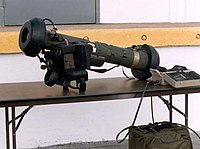
Photo from wikipedia
The purpose of this study was to clarify whether or not body armor would protect the body of a swine model using a blast tube built at National Defense Medical… Click to show full abstract
The purpose of this study was to clarify whether or not body armor would protect the body of a swine model using a blast tube built at National Defense Medical College, which is the first such blast tube in Japan. Seventeen pigs were divided into two groups: the body armor group and the non-body armor group. Under intravenous anesthesia, the pigs were tightly fixed in the left lateral position on a table and exposed from the back neck to the upper lumbar back to the blast wave and wind with or without body armor, with the driving pressure of the blast tube set to 3.0 MPa. When the surviving and dead pigs were compared, blood gas analyses revealed significant differences in PaO2, PaCO2, and pH in the super-early phase. All pigs injured by the blast wave and wind had lung hemorrhage. All 6 animals in the body armor group and 6 of the 11 animals in the control group survived for 3 hours after injury. Respiratory arrest immediately after exposure to the blast wave was considered to influence the mortality in our pig model. Body armor may have a beneficial effect in protecting against respiratory arrest immediately after an explosion.
Journal Title: Annals of biomedical engineering
Year Published: 2021
Link to full text (if available)
Share on Social Media: Sign Up to like & get
recommendations!